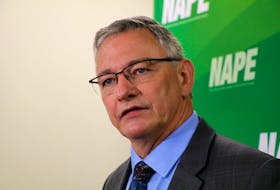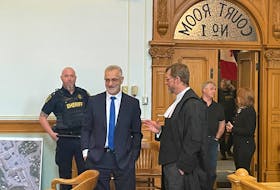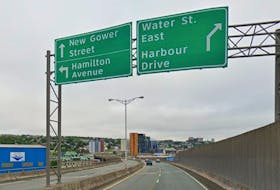There are other Canadians in the mix, but no foreign workers.
People from this province make up 92 per cent of the crew roster.
This is a rarity for the region’s offshore oil industry, with a high level of local employment attributed to the time the Henry Goodrich has spent here over the years — with more days to test Newfoundland and Labrador workers in all positions.
As local workers (residents as defined under the Elections Act) get to know the rig, and have a history with the operator, it makes it easier to bring them on the next time a drilling campaign comes along.
But it is also difficult for workers to know what to expect when new rigs enter the mix.
•••
In the fall of 2015, sitting in a coffee shop in Paradise, an offshore worker named John (not his real name) laid out the problem.
He asked that any identifying information provided — such as his latest position and employment history — not be shared. He was pressing, after all, for a questioning of the hiring practices of a company he hoped might possibly employ him down the road. And he did not want to be blacklisted.
He has experience, specifically offshore experience on drilling rigs, dating back decades.
But he has never been given the chance to work in his home province.
Working international turnarounds, John heard a few years ago that exploration would be picking up off eastern Canada. He got his hopes up.
“I started applying for work offshore Newfoundland. I thought my chances were really good. The (Seadrill) rigs were coming here for a fairly long term, with the requirement that Canadians be hired,” he said, giving his head a quick scratch and having a look at the other tables.
“I never got called for an interview,” he said.
He brushed it all off at first, he added, but then heard other workers who similarly never received a positive response to applications.
Then oil prices plummeted and layoffs started internationally.
“I spoke to quite a few people that work offshore (internationally) and they’re in the same boat,” he said, unemployed at the time.
He is now working another international job.
•••
In October 2015, a few weeks before The Telegram sat down with John, the CBC ran a story on local rig hires, with several workers anonymously questioning the number of “foreigners” on Seadrill’s West Aquarius and West Hercules.
Following up, The Telegram discovered Seadrill had more than 1,700 applicants from the local market for jobs on the West Hercules.
“Based on the review of the applications it was assessed that approximately 100 positions could be filed through this applicant pool,” stated a letter from Statoil Canada’s drilling manager Jim Beresford, from July 3, 2014, provided to the Canada-Newfoundland and Labrador Offshore Petroleum Board (CNLOPB).
In 2014, according to figures obtained through a federal access to information request, Seadrill counted a rig team for the West Hercules of 205 people, including six who are based onshore. Of that total, 120 jobs were handled by Newfoundland and Labrador residents, and 11 by other Canadians.
Seventy-four workers were from outside of Canada.
•••
The West Hercules was brought to the province for some of the new exploration work John was interested in — specifically an 18-month drilling campaign for Statoil.
The time period drove Seadrill’s decision to keep a core team of at least 60 Norwegians — Seadrill employees already working on the rig — on staff, according to Iain Cracknell, a spokesman for the company.
The team knew the machinery well, operating it in the North Sea before Statoil called the rig to Canadian waters.
The team will still be on it when it departs Newfoundland and Labrador.
“They will stay on when the rig returns to the North Sea,” Cracknell said, speaking with The Telegram by phone from Norway.
The CNLOPB was told up front: there was no intent by Seadrill nor by Statoil to press for the replacement of Seadrill’s expat employees, given the limited time for the rig in this province.
“This is based on the fact that the initial assessment of the local market was performed and the crew roster developed on the results of local interest. Also, the transition of senior personnel in and out over a short timeframe is viewed to impact overall crew competency and continuity,” reads the 2014 letter to the CNLOPB.
“However, the commitment remains that if through resignations or transfers a position becomes available, first consideration for employment opportunity will be given to qualified NL residents and then to Canadians.”
Seadrill’s West Aquarius, here longer than the West Hercules, has more locals on staff.
As of the end of 2015, the West Aquarius had a rig team of 208, with 162 being locals (up from 118 N.L. and Canadian residents combined expected in 2012).
•••
Local content on rigs has hinged on the length of operations.
But the province is preparing to press into an unprecedented level of exploration and early development work, with $1.2 billion in exploration spending commitments from a fall 2015 land sale already highlighted by the new Liberal government. And there remains no definition for what constitutes a short-term versus moderate- or extended-term work program.
If the West Hercules were here for three years, for example, would Statoil have started with more locals employed? What about just two years?
The CNLOPB can impose operator succession plans (they are filed before work begins), whereby oil companies will increase the percentage of locals employed if time frames change and a rig stays longer.
But no one can say absolutely when those kick in.
For the oil company’s part, when asked about the Seadrill rigs, a spokeswoman for Statoil noted rules around local hires are being followed.
“While there is no specific definition of short- versus long-term timeframes, Statoil co-ordinates our plans and activities with the CNLOPB to ensure we meet all legislative requirements in our operations,” she stated.
•••
“I’m not talking to you to crap on Seadrill. Seadrill’s going to do what they feel they’ve got to do to run their business,” John said, while sitting in that coffee shop, saying the same of Statoil.
But he was still stuck — a highly skilled worker watching Norwegians working in his home province while he prepared for his next international flight.
“This is where the CNLOPB should be looking after us.”
• • •
What the CNLOPB had to say
The joint provincial-federal offshore regulator signed off on the rig roster for the West Hercules, including more than 60 Norwegians.
Mike Baker, the CNLOPB’s director of administration and industrial benefits, was asked about the “local first” provision in the Atlantic Accords, given the approval.
“We wouldn’t see how many applications they get, or screened out, or screened in, or qualifications of candidates,” he said.
The law addresses only process, versus result. There are no explicit targets for the number of local hires on a rig, and the board is tasked with guaranteeing oil companies, through their contractors, consider local workers — not guarantee local hires.
Baker said the letter stating the count on applicants for positions on the West Hercules did not come to the board until the drilling program was underway.
“So it would be pretty much Monday morning quarterbacking kind of to look back and say, well why was that like that? And at that point in time the rig has been here and people are employed and it’s difficult for us to go back and look and say, OK, explain these 1,600 ... yah ... gap there,” he said, leaning over a copy of a letter on a boardroom table at the CNLOPB’s offices in St. John’s, checking the number of applicants.
Baker said the board does not object to rig owners maintaining a certain (although undefined) level of existing staff in the case of short-term campaigns. And some of that falls to safety, he said.
That applies to seismic vessels, diving vessels and deepwater construction vessels, in addition to rigs. For the ships, he said, anywhere from 30 per cent to 49 per cent local crew content could be expected here.
“To change out everybody from the captain on down to the deck hands wouldn’t be feasible. … The program wouldn’t even go ahead if they weren’t able to bring in a certain number of what we consider ‘key personnel,’” he said.
The ‘local first’ provision
From the Atlantic Accord Acts, Section 45:
A Canada–Newfoundland and Labrador benefits plan shall contain provisions intended to ensure that consistent with the Canadian Charter of Rights and Freedoms, individuals resident in the Province shall be given first consideration for training and employment in the work program for which the plan was submitted and any collective agreement entered into by the corporation or other body submitting the plan and an organization of employees respecting terms and conditions of employment in the offshore area shall contain provisions consistent with this paragraph.
There are other Canadians in the mix, but no foreign workers.
People from this province make up 92 per cent of the crew roster.
This is a rarity for the region’s offshore oil industry, with a high level of local employment attributed to the time the Henry Goodrich has spent here over the years — with more days to test Newfoundland and Labrador workers in all positions.
As local workers (residents as defined under the Elections Act) get to know the rig, and have a history with the operator, it makes it easier to bring them on the next time a drilling campaign comes along.
But it is also difficult for workers to know what to expect when new rigs enter the mix.
•••
In the fall of 2015, sitting in a coffee shop in Paradise, an offshore worker named John (not his real name) laid out the problem.
He asked that any identifying information provided — such as his latest position and employment history — not be shared. He was pressing, after all, for a questioning of the hiring practices of a company he hoped might possibly employ him down the road. And he did not want to be blacklisted.
He has experience, specifically offshore experience on drilling rigs, dating back decades.
But he has never been given the chance to work in his home province.
Working international turnarounds, John heard a few years ago that exploration would be picking up off eastern Canada. He got his hopes up.
“I started applying for work offshore Newfoundland. I thought my chances were really good. The (Seadrill) rigs were coming here for a fairly long term, with the requirement that Canadians be hired,” he said, giving his head a quick scratch and having a look at the other tables.
“I never got called for an interview,” he said.
He brushed it all off at first, he added, but then heard other workers who similarly never received a positive response to applications.
Then oil prices plummeted and layoffs started internationally.
“I spoke to quite a few people that work offshore (internationally) and they’re in the same boat,” he said, unemployed at the time.
He is now working another international job.
•••
In October 2015, a few weeks before The Telegram sat down with John, the CBC ran a story on local rig hires, with several workers anonymously questioning the number of “foreigners” on Seadrill’s West Aquarius and West Hercules.
Following up, The Telegram discovered Seadrill had more than 1,700 applicants from the local market for jobs on the West Hercules.
“Based on the review of the applications it was assessed that approximately 100 positions could be filed through this applicant pool,” stated a letter from Statoil Canada’s drilling manager Jim Beresford, from July 3, 2014, provided to the Canada-Newfoundland and Labrador Offshore Petroleum Board (CNLOPB).
In 2014, according to figures obtained through a federal access to information request, Seadrill counted a rig team for the West Hercules of 205 people, including six who are based onshore. Of that total, 120 jobs were handled by Newfoundland and Labrador residents, and 11 by other Canadians.
Seventy-four workers were from outside of Canada.
•••
The West Hercules was brought to the province for some of the new exploration work John was interested in — specifically an 18-month drilling campaign for Statoil.
The time period drove Seadrill’s decision to keep a core team of at least 60 Norwegians — Seadrill employees already working on the rig — on staff, according to Iain Cracknell, a spokesman for the company.
The team knew the machinery well, operating it in the North Sea before Statoil called the rig to Canadian waters.
The team will still be on it when it departs Newfoundland and Labrador.
“They will stay on when the rig returns to the North Sea,” Cracknell said, speaking with The Telegram by phone from Norway.
The CNLOPB was told up front: there was no intent by Seadrill nor by Statoil to press for the replacement of Seadrill’s expat employees, given the limited time for the rig in this province.
“This is based on the fact that the initial assessment of the local market was performed and the crew roster developed on the results of local interest. Also, the transition of senior personnel in and out over a short timeframe is viewed to impact overall crew competency and continuity,” reads the 2014 letter to the CNLOPB.
“However, the commitment remains that if through resignations or transfers a position becomes available, first consideration for employment opportunity will be given to qualified NL residents and then to Canadians.”
Seadrill’s West Aquarius, here longer than the West Hercules, has more locals on staff.
As of the end of 2015, the West Aquarius had a rig team of 208, with 162 being locals (up from 118 N.L. and Canadian residents combined expected in 2012).
•••
Local content on rigs has hinged on the length of operations.
But the province is preparing to press into an unprecedented level of exploration and early development work, with $1.2 billion in exploration spending commitments from a fall 2015 land sale already highlighted by the new Liberal government. And there remains no definition for what constitutes a short-term versus moderate- or extended-term work program.
If the West Hercules were here for three years, for example, would Statoil have started with more locals employed? What about just two years?
The CNLOPB can impose operator succession plans (they are filed before work begins), whereby oil companies will increase the percentage of locals employed if time frames change and a rig stays longer.
But no one can say absolutely when those kick in.
For the oil company’s part, when asked about the Seadrill rigs, a spokeswoman for Statoil noted rules around local hires are being followed.
“While there is no specific definition of short- versus long-term timeframes, Statoil co-ordinates our plans and activities with the CNLOPB to ensure we meet all legislative requirements in our operations,” she stated.
•••
“I’m not talking to you to crap on Seadrill. Seadrill’s going to do what they feel they’ve got to do to run their business,” John said, while sitting in that coffee shop, saying the same of Statoil.
But he was still stuck — a highly skilled worker watching Norwegians working in his home province while he prepared for his next international flight.
“This is where the CNLOPB should be looking after us.”
• • •
What the CNLOPB had to say
The joint provincial-federal offshore regulator signed off on the rig roster for the West Hercules, including more than 60 Norwegians.
Mike Baker, the CNLOPB’s director of administration and industrial benefits, was asked about the “local first” provision in the Atlantic Accords, given the approval.
“We wouldn’t see how many applications they get, or screened out, or screened in, or qualifications of candidates,” he said.
The law addresses only process, versus result. There are no explicit targets for the number of local hires on a rig, and the board is tasked with guaranteeing oil companies, through their contractors, consider local workers — not guarantee local hires.
Baker said the letter stating the count on applicants for positions on the West Hercules did not come to the board until the drilling program was underway.
“So it would be pretty much Monday morning quarterbacking kind of to look back and say, well why was that like that? And at that point in time the rig has been here and people are employed and it’s difficult for us to go back and look and say, OK, explain these 1,600 ... yah ... gap there,” he said, leaning over a copy of a letter on a boardroom table at the CNLOPB’s offices in St. John’s, checking the number of applicants.
Baker said the board does not object to rig owners maintaining a certain (although undefined) level of existing staff in the case of short-term campaigns. And some of that falls to safety, he said.
That applies to seismic vessels, diving vessels and deepwater construction vessels, in addition to rigs. For the ships, he said, anywhere from 30 per cent to 49 per cent local crew content could be expected here.
“To change out everybody from the captain on down to the deck hands wouldn’t be feasible. … The program wouldn’t even go ahead if they weren’t able to bring in a certain number of what we consider ‘key personnel,’” he said.
The ‘local first’ provision
From the Atlantic Accord Acts, Section 45:
A Canada–Newfoundland and Labrador benefits plan shall contain provisions intended to ensure that consistent with the Canadian Charter of Rights and Freedoms, individuals resident in the Province shall be given first consideration for training and employment in the work program for which the plan was submitted and any collective agreement entered into by the corporation or other body submitting the plan and an organization of employees respecting terms and conditions of employment in the offshore area shall contain provisions consistent with this paragraph.








